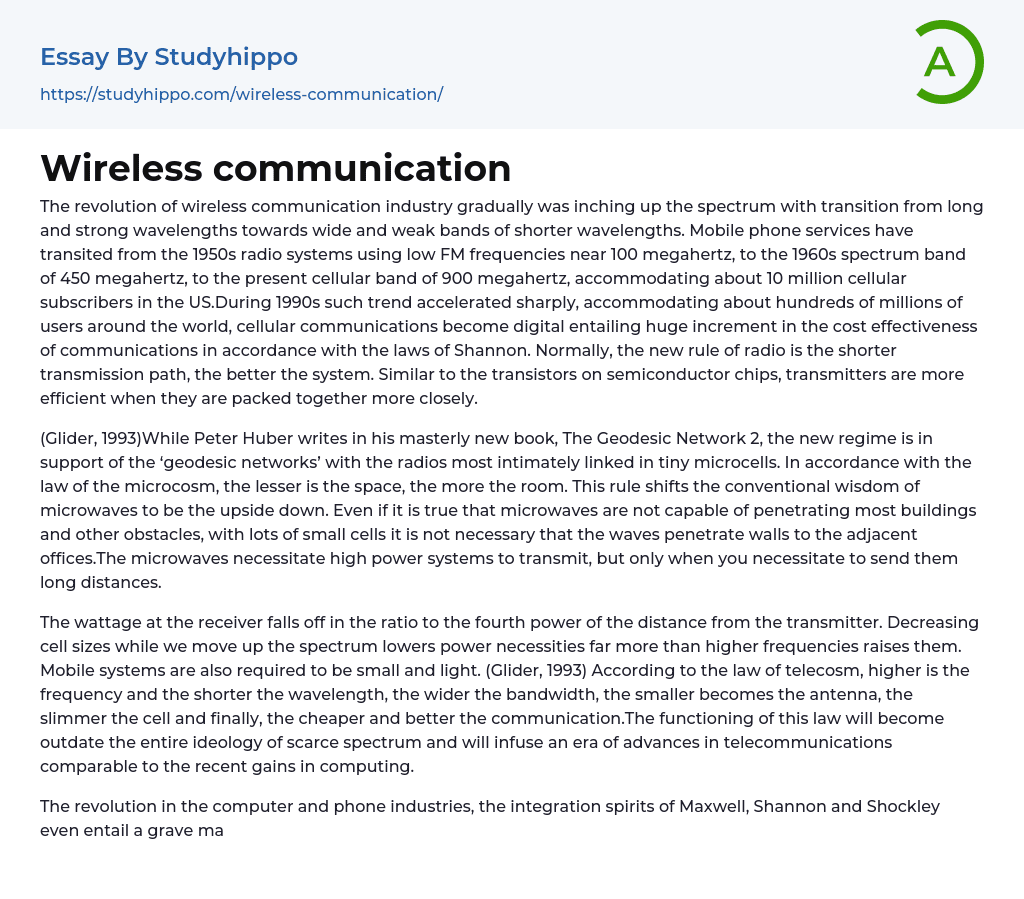The wireless communication industry has undergone a revolution, shifting from long and strong wavelengths to wider and weaker bands of shorter wavelengths. Mobile phone services have transitioned from using low FM frequencies in the 1950s, to spectrum bands of 450 megahertz in the 1960s, to the current cellular band of 900 megahertz, which serves around 10 million cellular subscribers in the US. This trend accelerated during the 1990s, accommodating hundreds of millions of users around the world as cellular communications became digital, leading to significant increases in cost effectiveness. This is consistent with Shannon's laws. The new rule for radio is that shorter transmission paths result in better systems. Like transistors on semiconductor chips, transmitters are more efficient when they are packed closely together.
(Glider, 1993) According to Peter Huber's book, "The Geodesic Network 2," the new trend is in favor o
...f "geodesic networks" where radios are closely linked in tiny microcells. This approach follows the law of the microcosm, which states that smaller spaces provide more room. This rule turns the conventional idea about microwaves upside down. Although microwaves cannot penetrate most obstacles including buildings, with multiple small cells, there is no need for the waves to penetrate walls into adjacent offices. Transmitting microwaves requires a high-power system only for long distances.
According to Glider (1993), as per the law of telecosm, higher frequency and shorter wavelength result in wider bandwidth, smaller antennas, slimmer cells, and cheaper/better communication. Decreasing cell sizes while moving up the spectrum reduces power needs more than higher frequencies can increase them. Furthermore, mobile systems must be compact and lightweight due to their design requirements. The power received at the receiver diminishe
in proportion to the fourth power of the distance from the transmitter. This law will render the entire ideology of scarce spectrum outdated and usher in a new era of progress in telecommunications similar to recent advances in computing.
Maxwell, Shannon, and Shockley's integration spirits and revolution in the computer and phone industries have left a significant mark on the present cellular telephony revolution. Despite being optimistic about the impact of wireless on the computer industry, others have predicted that computers will have a greater impact on wireless. Personal Communications Networks (PCN) are ushering in a new era of revolution in the cellular industry. Much like how personal computers led to highly efficient systems in MIPS per dollar, PCNs will also result in an exponential plunge of costs.
The plan is to establish networks consisting of microcells that cover a few hundred meters instead of several miles. These networks will connect intelligent digital devices, which consume power in milliwatts, unlike conventional phones that consume watts. The cellular phone is set to become the most ubiquitous personal computer globally. The European leaders initiated a new digital cellular system known as Groupe Speciale Mobile -- GSM, with the aid of engineers from Ericsson and under the influence of industrial politicians from EEC. GSM is a typical digital system that triples the number of users in each cellular channel and utilizes time-division multiple access -- TDMA. (Glider, 1993) Steinbrecher's system offered the foundation for a groundbreaking wireless computer telephony scheme that operates in a distributed network.
CDMA technology was developed as a means of preventing jamming or interception of military communications. This system utilizes Shannon's approach of transmitting wide and weak
signals in order to achieve greater bandwidth. Qualcom has taken on the challenge of applying CDMA to cellular communication in urban areas, where smaller cells with lower power at higher frequencies are becoming increasingly common.
According to Glider (1993), the upcoming decade will witness the rise of various PCN, digital video, multimedia, and wireless computer technologies, leading to fluctuating fortunes for businesses that work with cable and cellular technology.
- Greeting essays
- Orality essays
- Intercultural Communication essays
- Interpersonal Communication essays
- Cross-Cultural Communication essays
- Nonverbal Communication essays
- Effective Communication essays
- Communication Skills essays
- Talk Radio essays
- Cellular Network essays
- Router essays
- Arranged Marriage essays
- Communication essays
- Conflict Management essays
- Conflict Resolution essays
- Connection essays
- Conversation essays
- Dating essays
- Friendship essays
- Mediation essays
- Atom essays
- Big Bang Theory essays
- Density essays
- Electricity essays
- Energy essays
- Force essays
- Heat essays
- Light essays
- Motion essays
- Nuclear Power essays
- Physiology essays
- Sound essays
- Speed essays
- Temperature essays
- Thermodynamics essays
- Collaboration essays
- Dialogue essays
- Fake News essays
- Journalism essays
- Mass Media essays
- Media Analysis essays
- Media Bias essays
- Media Studies essays
- Message essays
- News essays
- Propaganda essays
- Radio essays
- Rogerian Argument essays
- Role of Media essays
- Social Media essays




